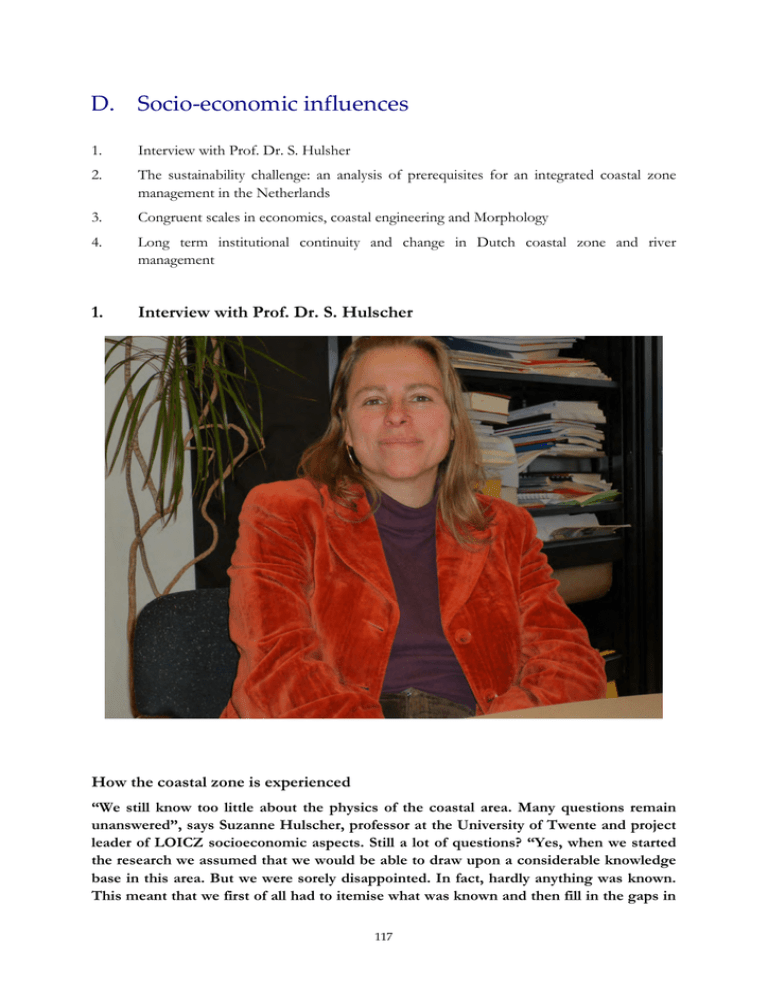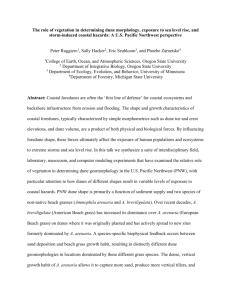D. Socio-economic influences
advertisement

D. Socio-economic influences 1. Interview with Prof. Dr. S. Hulsher 2. The sustainability challenge: an analysis of prerequisites for an integrated coastal zone management in the Netherlands 3. Congruent scales in economics, coastal engineering and Morphology 4. Long term institutional continuity and change in Dutch coastal zone and river management 1. Interview with Prof. Dr. S. Hulscher How the coastal zone is experienced “We still know too little about the physics of the coastal area. Many questions remain unanswered”, says Suzanne Hulscher, professor at the University of Twente and project leader of LOICZ socioeconomic aspects. Still a lot of questions? “Yes, when we started the research we assumed that we would be able to draw upon a considerable knowledge base in this area. But we were sorely disappointed. In fact, hardly anything was known. This meant that we first of all had to itemise what was known and then fill in the gaps in 117 knowledge before we could start on the actual aim of the research, namely bringing together the morphological aspects and the socioeconomic dimension.” What exactly was not known? Hulscher: We knew little about the dynamics of the dune areas and exactly how the dunes are managed. Up until now all the safety models assumed that the coastal area was static and remained unchanged, even though that is clearly not the case. There is nothing more changeable than the dunes. If you want to make socioeconomic statements about that area then you need to know more about dune dynamics. And about safety? Yes, and about safety. Although they number but a few, some people live on the unsafe side of the dune erosion line. These people like living there even though they know there are risks involved. They appear to be prepared to run those risks. Yet are they really aware of what those risks are? And what factors other than safety play a role in their choice? Just exactly how rational or emotional is the choice made? Can we discover patterns in these decisions? And what if we know all of this? Then the next question is whether the government has the duty to inform these people about the risks involved. We can ask ourselves if society has the obligation to prohibit people from living at these locations. What do these considerations mean for the price of the houses concerned? Our research can reveal how risk perception affects people's choices to live by the sea at locations in the safety zone. What was the first step in the research? We first of all documented the various management measures over the past thirty years. At the same time, we investigated the dynamics of the dunes in the Netherlands and an unmanaged area of dunes along the Danish coast. We wanted to know the effect of planting European marram grass and how quickly dunes shift. Why did you want to know that and how could that information help a policy maker? If you know how the dunes change, how quickly, and why, then you know what to expect and how to allow for that. Then you can respond to the changes. Should you issue permits to residents for houses outside of the safety zone? How can you reach responsible choices? What’s new in the research? Until quite recently the research mainly focussed on the physical and morphological phenomena. How high or wide are the dunes? At this moment we are mainly interested in the socioeconomic aspect of the area. The research has become more complex because it has become 118 multidisciplinary. We want to know more about the physical aspects of safety. We want to possess enough knowledge to make sustainable choices for the longer term. Stabilising the dunes is too expensive, because you need to perform a range of interventions to keep the dunes in place. However, it is not only expensive. It also goes against the natural dynamics, and nowadays our ethos is more attuned to working with nature: Building With Nature. That can be more responsible from an ecological perspective as well as cheaper. We need to get away from our small-scale approach to working. I am calling for a national and integrated approach in which we not only look at the morphological changes but also the sociological and economic effects of these. 119





